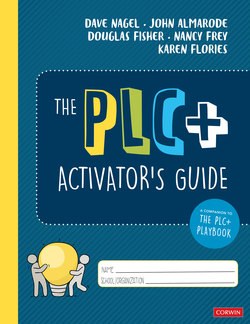Читать книгу The PLC+ Activator’s Guide - Douglas Fisher - Страница 6
На сайте Литреса книга снята с продажи.
Letter From the Authors
ОглавлениеDear Educator,
In our collective years of experience, we have never come across anyone who works in education who has said, “I have too much spare time on my hands, so I would love to attend another meeting.” In our schools and classrooms, time is at a premium. If the school day begins at or around 8:00 a.m. and dismissal occurs somewhere on or around 3:00 p.m., this gives us a seven-hour school day at best. When you remove the time devoted to transitions, lunch, and the logistics of being in school (e.g., packing up, unpacking, announcements), those seven hours quickly tick away. We are not saying that transitions, lunch, and the logistics are not important, but we are highlighting the need for protecting our time outside of instructionally focused efforts. This brings us back to the above comment about “another meeting.” As we pointed out in PLC+: Better Decisions and Greater Impact by Design and The PLC+ Playbook, Grades K–12: A Hands-On Guide to Collectively Improving Student Learning (Fisher, Frey, Almarode, Flories, & Nagel, 2020a, 2020b, Corwin), your PLC meetings may have lost their efficiency and effectiveness, relegating them to the category of “another meeting.” We are confident in this hypothesis simply because you chose to read this guide for activators. For that we are grateful; we believe that the ideas in this guide will serve as a catalyst to the collective and successful work of you and your colleagues—work that will take you beyond the feeling that PLC+ just means another meeting to endure.
With that said, we want to share two very important things we are passionate about when it comes to PLCs:
1 We are passionate about helping educators leverage their expertise to lead and develop actions that support their PLC+.
2 We are passionate about supporting the work of educators as they strive to maximize their impact on student learning.
As we engaged in the development and implementation of PLC+, we immediately recognized the difference between those PLC meetings that translated our two passions into action and those PLC meetings that encountered challenges in moving professional conversations, and thus learning, forward in schools and classrooms. In some conference rooms, PLC meetings digressed into topics not related to the upcoming teaching and learning. In other grade-level planning sessions, PLCs did not address the root cause or underlying challenge impacting the students’ learning outcomes. They missed the white elephant in the room, or the pink gorilla—whatever you want to call it. And finally, some of the PLCs spun their wheels on a particular topic, draining the desire and passion of the team. After all, simply staring at the challenge or opportunity, almost admiring it, can be exhausting.
Thus enters the activator and the very purpose of The PLC+ Activator’s Guide. One way PLC+ teams can proactively avoid some of these and other common pitfalls is by having a strong activator. Activation, one of the crosscutting values of the PLC+, was intentionally built into the framework to highlight the importance of moving the dialogue and discussion forward in an intentional and purposeful way.
1 We must keep the equity of access and opportunity for learning at the forefront of each PLC+ collaborative team meeting.
2 We must ensure that activation of the dialogue is provoked by the five questions and is carried out in such a way that the work of the PLC+ is accelerated, not hindered or impeded.
3 We must develop learning experiences that make our expectations for learning clear to all students.
4 And finally, the collaborative work of the PLC+ should leverage our individual efficacy into collective teacher efficacy.
The PLC+ Activator’s Guide is broken down into eight parts with each part supporting your development as an activator. The purpose of the guide is to create a pathway for this activation to take place with regularity and consistency within a PLC+. Let us be clear—this guide seeks to build capacity within each member of the PLC+ team such that, over time, all members will recognize activation points in the work of the PLC+ team and provoke dialogue and discussion around the five PLC+ guiding questions in a way that continuously moves the learning of both students and teachers forward.
We welcome you to the role of activator as you begin your journey through The PLC+ Activator’s Guide. Over the eight parts of this book, we will present new content while incorporating key concepts from the core PLC+ book and The PLC+ Playbook. Together, we will engage in an interactive exploration and analysis of the why, how, and what of PLC+ through the eyes of an activator. Although all protocols in The PLC+ Playbook were designed to be used collaboratively in your PLC+, we will highlight many, but not all, in our journey to develop activators. Thank you for your commitment and service to teaching and learning.
Dave, John, Douglas, Nancy, and Karen
